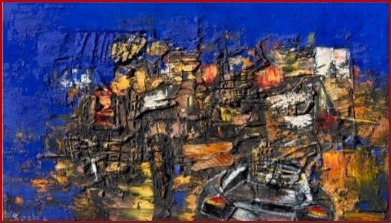 Lamborghini is kicking off celebrations for the 50th Anniversary of the Miura with an art exhibit entitled, “Velocità e Colore” (Speed and Color), which will be on display from April 28 to June 30 at Lamborghini’s historic museum in Sant’Agata Bolognese, Italy.
Lamborghini is kicking off celebrations for the 50th Anniversary of the Miura with an art exhibit entitled, “Velocità e Colore” (Speed and Color), which will be on display from April 28 to June 30 at Lamborghini’s historic museum in Sant’Agata Bolognese, Italy.
Local artist Alfonso Borghi from Campegine was invited to interpret the Miura and the marque of the Raging Bull. “Their spirit, essence and colors are expressed in his ten works on display,” according to Lamborghini.
Borghi’s painting is said to be the product of an “unconscious revision of the dynamic shapes, the stylistic elements of fine design, and the innovations in color.” With strong interplays of color and three-dimensional effects, ten canvasses in a large size reveal specific details of the Lamborghinis of today and yesteryear – from the iconic Miura to the Reventón, Sesto Elemento and Aventador.
Lamborghini CEO Stefano Domenicali said, “The encounter of art and automotive legend is a winning combination. From the first cars we produced to the vehicles of today, Lamborghinis have been masterworks of automotive art in which expert craftsmanship is fused with engineering genius and design.”
The Miura, introduced 50 years ago this year, is a unique automobile that revolutionized the sports car world in the 1960s. Designed in 1965 by a Lamborghini engineering team headed by Gian Paolo Dallara and Paolo Stanzani, and with a body conceived by Marcello Gandini for Carrozzeria Bertone, it immediately became a highly coveted car for those who could afford it. It was only 105 centimeters tall and had a minimum ground clearance of only 135 millimeters.
The Miura was introduced at the Geneva Motor Show in 1966 and was an immediate international hit that transformed the sports car world. Its transverse rear 4-liter 60-degree V12 mid-engine was joined to a transaxle to form a single unit. Rated at 350 horsepower at 7000 RPM, the powertrain produced a record maximum speed (at the time) of 280 km/h. Its refined, highly modern design was way ahead of its time and was undoubtedly inspired by the great racing prototypes of the time that vied for first place in long-distance races. The rear engine technology in these cars would be generally incorporated into elegant sports cars driven on the street only many years later.
With the Miura, which took its name from Edoardo Miura, who was a close friend of founder Ferruccio Lamborghini and a famous breeder of bulls, Lamborghini began the tradition of naming its cars after Spanish bullfighting.

